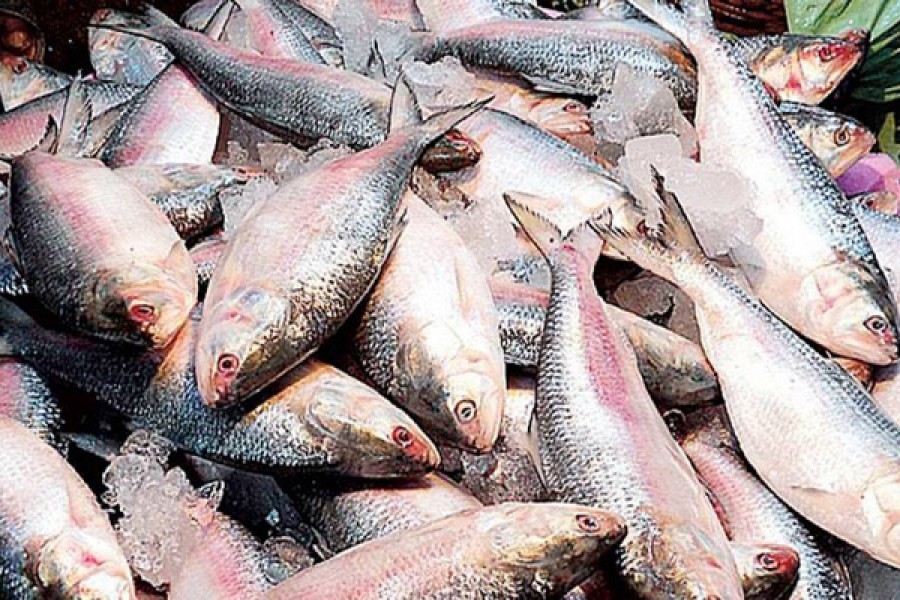Two Bangladesh-based research teams have announced that they have successfully mapped the genome sequence of the hilsa fish.
Though both groups conducted their research separately, they announced their results to the media nearly simultaneously.
A genome is the complete set of genes or genetic material present in an organism. The genome sequence is the order of DNA neucleotides that make up the organism’s DNA. The particular sequence of these neucleotides determines many of an organism’s characteristics.
Scientists believe that discovering the genome sequence of the hilsa fish will provide a holistic understanding of the organism’s biology and can be used to increase its production and ensure its conservation.
Nearly 75 per cent of the world’s hilsa comes from Bangladesh. Hilsa production is nearly 10 per cent of the country’s total fish production.
Bangladesh produces nearly 387,000 tonnes of hilsa a year, with a total market value of Tk 158.7 billion. Hilsa production composes nearly 1.0 per cent of Bangladesh’s GDP.
Last year the hilsa was internationally recognised as a geographical indication (GI) product of Bangladesh.
Prof Dr Samsul Alam of the Department of Fisheries Biology and Genetics at Bangladesh Agricultural University (BAU) led one of the research teams investigating the hilsa genome.
Other members of the research team included Prof Dr Bazlur Rahman Mollah of poultry science, Prof Dr Shahidul Islam of biotechnology, and Prof Dr Mohammad Golam Quader Khan of fisheries biology and genetics.
The Agricultural University group says it began its research in December 2015. It collected DNA samples from adult hilsa in the Bay of Bengal and the Meghna River and successfully mapped the gnome within two years, the research team said.
According to Prof Alam, the hilsa genome has 7.68 million nucleotides, nearly a quarter of the number found in humans. The complete sequence will help answer numerous questions about the species, he said.
“Hilsa breeds twice a year. We can now investigate whether different types of hilsa breed in different times, whether the stock of hilsa in the Padma and Meghna are different, whether those hilsa spawn that are born in certain rivers return to them for breeding after they have grown in the sea – we can find an answer to all these questions through the genome.”
The other research team was led by Dhaka University Department of Biochemistry and Molecular Biology’s Prof Haseena Khan, though the project was initiated by Bangladeshi-born biotechnologist Dr Mong Sano Marma.
The team also included bioinformatician AKM Abdul Baten, researcher Dr Peter Ianakiev, Prof Mohammad Riazul Islam, Lecturer Farhana Tasnim Chowdhury, and young researchers Avizit Das, Oly Ahmed, Julia Nasrin, Tasnim Ehsan and Rifath Nehleen of the biochemistry and molecular biology department at Dhaka University.
The research was conducted in the US, Australia and at Dhaka University after Dr Marma submitted the proposal, said Prof Khan. Their discoveries have yet to be sent to any international forum, she said.
The team collected DNA and RNA samples from hilsa fish at several locations, including rivers, estuaries and the sea. Research was then conducted separately in Dhaka, the US and Australia.
The full results were arranged by Dr Marma in the US. The DNA assembly work was done in Australia. The other members of the research team in Dhaka are working on decoding the RNA of the hilsa.
Who gets the credit?
Both teams have remarked on the others’ results.
News of the success of Dr Marma and Prof Khan’s team had been carried by several media outlets in the past few days. The Agriculture University team announced its findings on Saturday and raised allegations against the other team.
Prof Alam said that their research work had been completed a year ago and that the team had decided to announce their findings to the world at a press conference on September 10. The team had sent invitations to all universities in the country on the occasion, bdnews24 reported.
“We sent invitations to Dhaka University on September 3. Having seen the cards, they rushed to take credit and gave misleading information to news outlets to get them to write stories. It is unacceptable.”
Dr Bazlur Rahman Mollah, part of Prof Alam’s team, said: “We presented our research at the Dhaka University Senate Building in December 2017. It is incomprehensible to me how they could have done this even after knowing that. Our research can be found with a Google search, but nothing has been released regarding their research.”
Asked why her team had not sent the data to an international forum, Prof Haseena Khan said, “Sending it to an international forum means submitting it to a public database. As soon as that is done it dismisses all property rights we have to it in Bangladesh. Once it was submitted to a database we would not be able to maintain control over it. Anyone would have access to it. That is why I have not sent it yet.”
Questioned about the Agriculture University team’s claims, she said: “We worked on the nucleus genome, which is the real genome. They have submitted research on the mitochondrial genome. If they have worked on the nucleus genome, they have not submitted it.”
“They found 768 million units in the DNA. We found 1.0 billion, nearly 250 million more. Through various means we have learnt our genome is 95 per cent complete, which is very good information.”
Prof Khan said she had not received any invitation sent by the Agriculture University research team.


